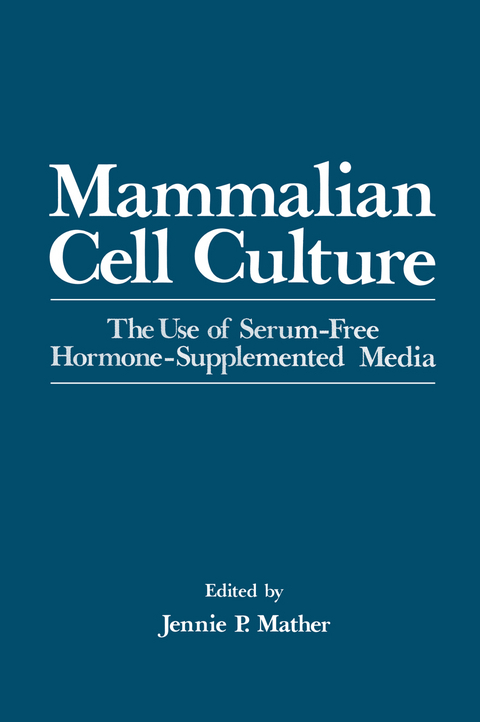
Mammalian Cell Culture
Springer-Verlag New York Inc.
978-1-4615-9363-8 (ISBN)
The advantages of obtaining a completely defined environment for the growth of cells in vitro were recognized very early in the history of cell culture (Lewis and Lewis, 1911). Continued interest in the nutritional requirements of cells in vitro and in providing an optimal environment for cells led to the development of the complex nutrient mixtures available today in many media (Waymouth, 1972; Ham, 1965). However, serum remained an essential component of medium for the growth of most cell types in culture. The question of what factor (or factors) in serum was essential for cell growth and survival remained unanswered for several decades. Initially, experiments were designed to purify the "active component" of serum for the growth of cells in culture. These experiments identified fetuin (Fisher et at., 1958) and nonsuppressible insulinlike activity (Temin et at., 1972) as important components of serum. However, the complexity of serum and the very low levels of active components in serum hindered progress in identi fying and isolating serum factors.
1 Serum Factor Requirements for the Initiation of Cellular Proliferation.- Multiple Serum Components Required for Cellular Proliferation.- EOF and Somatomedin C Can Replace the GQ/GI Progession Activity of PPP.- EGF and Somatomedin C Reduce the Minimum Gi Transit Time.- Availability of Free Somatomedin C Controls Minimum Gi Transit Time.- Somatomedin C Regulates Progression of Late Gi Phase and Commitment to DNA Synthesis.- EGF Is Required during Traverse of Early Gi.- Summary and Conclusions.- References.- 2 Regulation of Fibroblast Growth by Multiple Growth Factors in Serum-Free Medium.- In Vitro Models of Growth Regulation—Why Do Cells Arrest Their Growth?.- Neoplastic Transformation and Relaxed Growth Regulation.- Replacing Serum with Defined Medium Components to Study Growth Regulation In Vitro.- Combinations of Growth Factors Are Required in Defined Media to Support Cell Proliferation.- Mechanism of Growth Factor Action—Events Stimulated by Growth Factors Prior to DNA Synthesis.- Comparison of the Growth Factor Requirements of Normal and Transformed Cells Grown in Serum-Free Media.- Conclusion.- References.- 3 Growth and Differentiation of Preadipocyte Cell Lines in Serum-Free Medium.- Results and Discussion.- References.- 4 Growth and Differentiation of Human Myelomonocyte Leukemia Cell Lines in Serum-Free Medium.- Human Myelomonocytic Cell Lines.- Growth of HL-60 in Defined Medium.- Differentiation of HL-60 in Defined Medium.- Involvement of Intracellular Cyclic Adenosine 3?:5?-Monophosphate (cAMP) in Differentiation of HL-60.- Differentiation Effects of Agents That Increase Intracellular cAMP on HL-60 Primed with RA.- Growth and Differentiation of Other Myelomonocytic Cell Lines in Defined Medium.- References.- 5 In Vitro Immunization and Growth ofHybridomas in Serum-Free Medium.- In Vitro Immunization.- The Role of Serum.- Thiols.- Cellular Interactions and Soluble Factors.- Serum-Free Media.- Conclusion.- References.- 6 Kidney Cell Cultures in Hormonally Defined Serum-Free Medium.- Kidney Cell Culture in Serum-Supplemented Medium: MDCK and LLC-PKl as Model Systems.- Advantages of Kidney Cell Culture.- Limitations on Transport Studies with Kidney Cell Culture Imposed by Serum.- Limitations of Studies with Established Kidney Cell Lines: Importance of Primary Kidney Cell Culture.- Primary Kidney Culture and Hormonally Defined Medium.- Primary Culture of Specific Kidney Cell Types.- Use of Hormonally Defined Serum-Free Medium to Grow Specific Cell Types in the Kidney: The Concept of Selective Media.- Use of Primary Kidney Cell Culture to Study Medically Related Problems of the Kidney.- References.- 7 Rat Hepatocytes in Culture: A Model for Studies of Growth Control during Experimental Chemical Hepatocarcinogenesis.- Control of DNA Synthesis in Cultures of Adult Rat Hepatocytes.- Factors Required for the Induction of DNA Synthesis.- Platelet-Derived Growth Factor as an Inhibitor of Normal Hepatocyte DNA Synthesis.- Stimulatory Activity for Normal Hepatocyte DNA Synthesis in the Serum from Cancer Patients and Carcinogen-Fed Rats.- Altered Response of Hepatocytes from Carcinogen-Treated Rats to PDGF.- Discussion.- References.- 8 Intratesticular Regulation: Evidence for Autocrine and Paracrine Control of Testicular Function.- Testicular Cell Culture.- Autocrine Regulation of Testicular Cells.- Cell-Cell Interaction in the Testis.- Summary and Model of Intratesticular Regulation.- References.- 9 Attachment Factors in Cell Culture.- Collagen.- Fibronectin.- Laminin.- Chondronectin.- Serum-Spreading Factor.- Epibolin.- Fetuin.- Extracellular Matrix in Cell Culture.- Future Trends: Studies of Cell Shape and Cell-Substratum Interactions.- References.- 10 Cell Culture Studies Using Extracts of Extracellular Matrix to Study Growth and Differentiation in Mammalian Cells.- Background on Extracellular Matrix.- Cell Culture Methods Using Crude Extracts of Extracellular Matrix.- The Future.- References.
| Zusatzinfo | XVIII, 284 p. |
|---|---|
| Verlagsort | New York, NY |
| Sprache | englisch |
| Maße | 152 x 229 mm |
| Themenwelt | Sachbuch/Ratgeber ► Natur / Technik ► Naturführer |
| Studium ► 1. Studienabschnitt (Vorklinik) ► Anatomie / Neuroanatomie | |
| ISBN-10 | 1-4615-9363-8 / 1461593638 |
| ISBN-13 | 978-1-4615-9363-8 / 9781461593638 |
| Zustand | Neuware |
| Haben Sie eine Frage zum Produkt? |
aus dem Bereich


